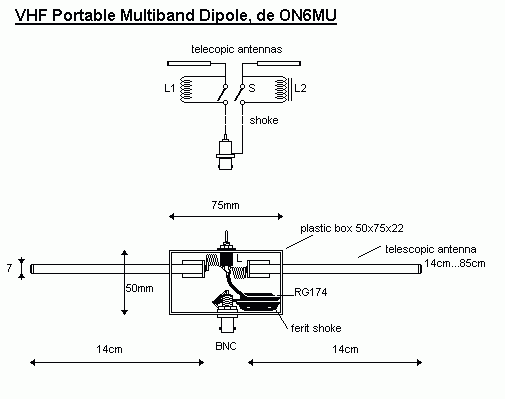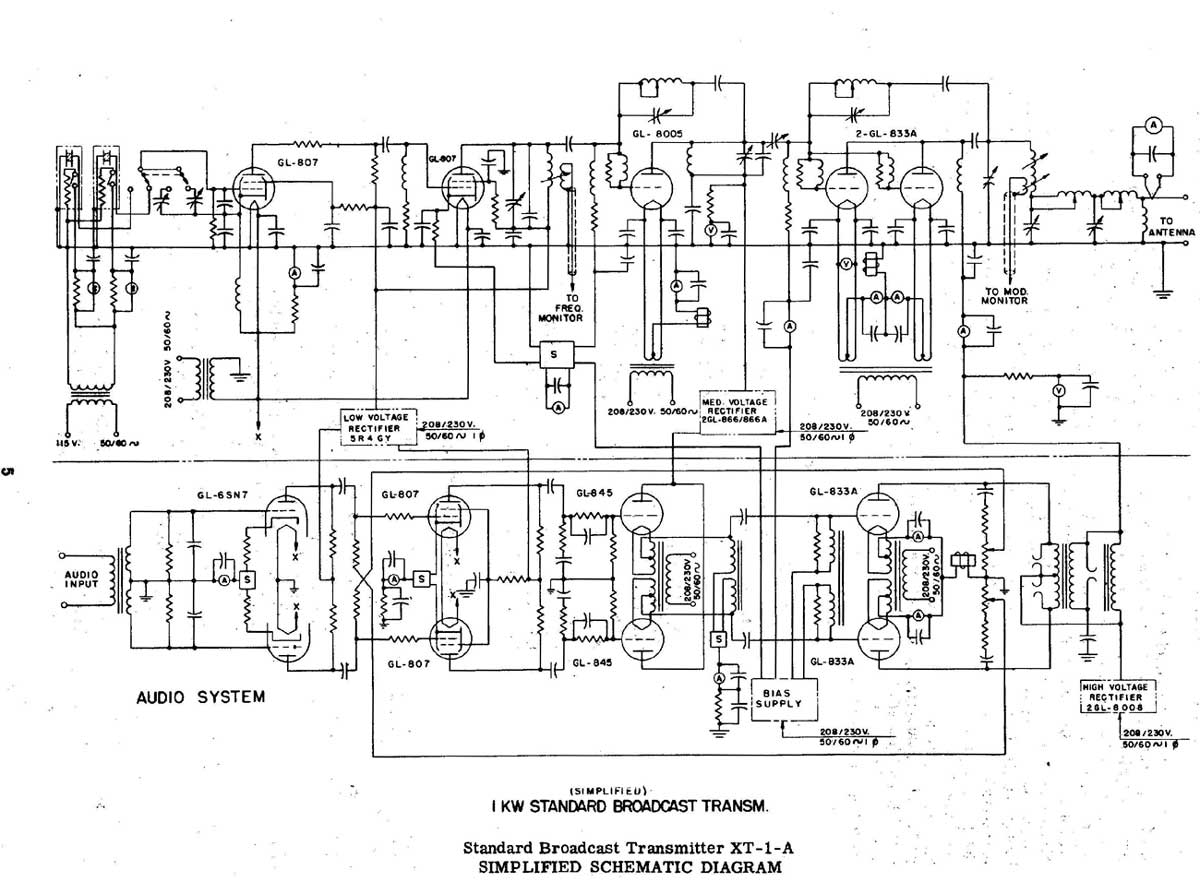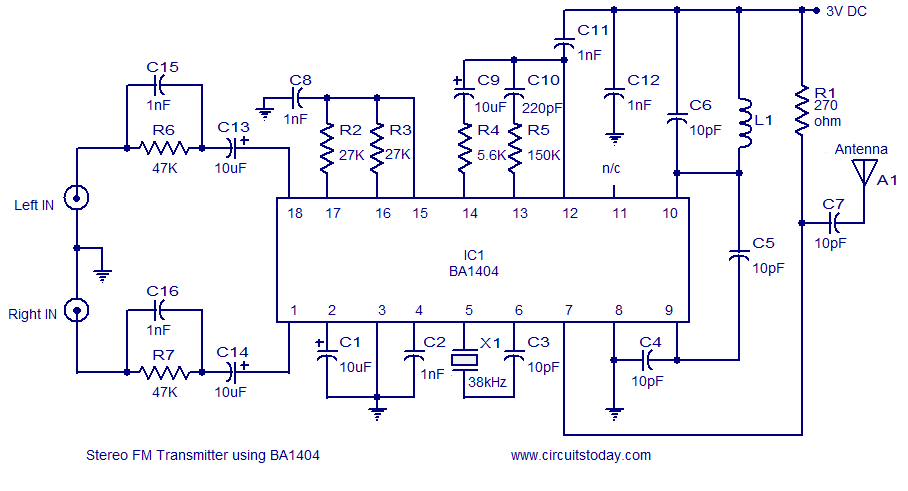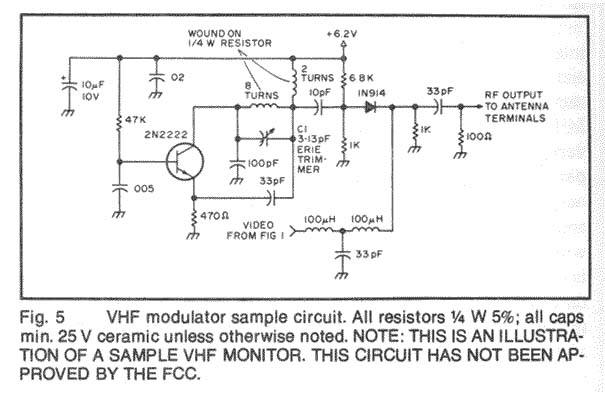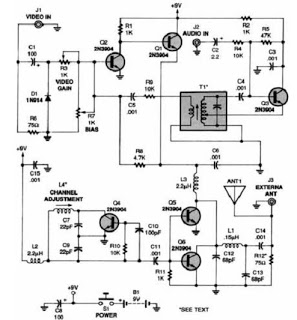
vhf fm transmitter
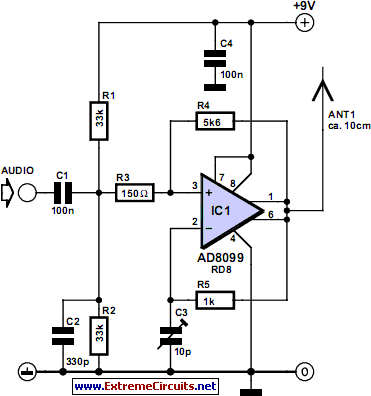
Integrated circuits (ICs) that were once prohibitively expensive for hobbyists are now more affordably priced. A notable example is the AD8099 from Analog Devices, which is available for a modest cost. The AD8099 is a high-speed operational amplifier (op-amp) with a slew rate of 1600 V/µs, high-impedance inputs, and low input capacitance. Its bandwidth is substantial, maintaining a gain of nearly 40 at 100 MHz. This characteristic allows for the construction of an RC oscillator using this op-amp. The circuit exhibits several distinctive features. Firstly, it does not utilize any inductors, which is atypical for standard oscillators that employ transistors. Secondly, it eliminates the need for a varicap diode for frequency modulation. The op-amp is configured as a Schmitt trigger with minimal hysteresis, and the output is fed back through an RC circuit. This setup causes the trimmer capacitor to be continuously charged and discharged when the voltage reaches the hysteresis threshold, resulting in a toggling output and producing a square wave output voltage. With a 10-pF trimmer capacitor, the frequency can be adjusted within the VHF FM broadcast band (88-108 MHz), providing sufficient stability. The output voltage reaches approximately 6 Vpp with a 9 V power supply, delivering about 50 mW of power at a 50-ohm load, which is significantly higher than typical transistor-based oscillators. A short antenna of approximately 10 cm allows for adequate range in home testing, although the presence of harmonics necessitates caution against using an outdoor antenna without additional filtering, such as a pi-filter. Frequency modulation is achieved by varying the hysteresis, which affects the oscillator frequency, and an audio signal of around 20 mVpp suffices for a reasonable output amplitude. The op-amp comes in an 8-pin SOIC package (specifically the version with the RD8 suffix), with pin spacing of 1/20 inch (1.27 mm), facilitating soldering with appropriate tools. If SMD components are also utilized, the circuit can be compact. An additional transistor may be incorporated as a microphone amplifier if desired. The power supply voltage should not exceed 12 V, as the IC is not rated for higher voltages. At 9 V, the current consumption is only 15 mA. As with all free-running oscillator circuits, variations in power supply voltage can affect output frequency stability, making a voltage regulator advisable for optimal performance. Furthermore, the circuit can be adapted for use as a voltage-controlled oscillator (VCO) in phase-locked loop (PLL) applications by substituting the trimmer capacitor with a varicap diode, thereby increasing frequency range beyond that achievable with an LC oscillator. The tuning range of an RC oscillator is proportional to the entire capacitance ratio, unlike LC oscillators, where the tuning range is proportional to the square root of the capacitance ratio. For instance, a capacitance ratio of 1:9 in an RC oscillator allows for a tuning range of 1:9, while an LC oscillator achieves only 1:3. Additionally, this circuit can provide sufficient output power to drive a diode mixer, such as the SBL-1, which requires a local oscillator signal with 5 to 10 mW of power, thus the 50 mW output from this oscillator is adequate, and a simple resistor-based attenuator can be employed for matching.ICs that in the past were far too expensive for the hobbyist tend to be more favourably priced these days. An example of this is the AD8099 from Analog Devices. This opamp is available for only a few pounds. The AD8099 is a very fast opamp (1600 V/ms) and has high-impedance inputs with low input capacitance.
The bandwidth of the opamp is so large that at 100 MHz it still has a gain of nearly 40. This means that this opamp can be used to create an RC oscillator. The circuit presented here realises that. The circuit has a few striking characteristics. Firstly, unlike normal oscillators that contain transistors this one does not have any inductors. Secondly, there is no need for a varicap diode to do the FM modulation. The opamp is configured as a Schmitt trigger with only a small amount of hysteresis. The output is fed back via an RC circuit. In this way, the trimmer capacitor is continually being charged and discharged when the voltage reaches the hysteresis threshold. The output continually toggles as a consequence. This results in a square wave output voltage. With a 10-pF trimmer capacitor the frequency can be adjusted into the VHF FM broadcast band 88-108 MHz).
The frequency of the oscillator is stable enough for this. The output voltage is about 6 Vpp at a power supply voltage of 9 V. The transmitter power amounts to about 50 mW at a load of 50R. This is about 20 times as much as the average oscillator with a transistor. With a short antenna of about 10 cm, the range is more than sufficient to use the circuit in the home as a test transmitter. Because the output signal is not free from harmonics the use of an outdoor antenna is not recommended.
This requires an additional filter/adapter at the output (you could use a pi-filter for this). The FM modulation is achieved by modulating the hysteresis, which influences the oscillator frequency. An audio signal of about 20 mVpp is sufficient for a reasonable output amplitude. The package for the opamp is an 8-pin SOIC (provided you use the version with he RD8 suffix). The distance between the pins on this package is 1/20 inch 1. 27 mm). This is still quite easy to solder with descent tools. If SMD parts are used for the other components as well then the circuit can be made very small. If necessary, a single transistor can be added to the circuit to act as microphone amplifier. The power supply voltage may not be higher than 12 V, because the IC cannot withstand that. The current consumption at 9 V is only 15 mA. As with all free-running oscillator circuits, the output frequency of this specimen is also sensitive to variations of the power supply voltage.
For optimum stability, a power supply voltage regulator is essential. As an additional design tip for this circuit, we show an application as VCO for, for example, a PLL circuit. When the trimmer capacitor is replaced with a varicap diode, the frequency range can be greater than that of an LC oscillator.
That`s because with an LC-oscillator the range is proportional to the square root of the capacitance ratio. With an RC oscillator the range is equal to the entire capacitance ratio. For example: with a capacitance ratio of 1:9, an LC oscillator can be tuned over a range of 1:3. With an RC oscillator this is 1:9. For the second tip, we note that the circuit can provide sufficient power to drive a diode mixer (such as a SBL-1) directly.
This type of mixer requires a local oscillator signal with a power from 5 to 10 mW and as already noted, this oscillator can deliver 50 mW. A simple attenuator with a couple of resistors is sufficient in this case to adapt the two to each other.
🔗 External reference
The bandwidth of the opamp is so large that at 100 MHz it still has a gain of nearly 40. This means that this opamp can be used to create an RC oscillator. The circuit presented here realises that. The circuit has a few striking characteristics. Firstly, unlike normal oscillators that contain transistors this one does not have any inductors. Secondly, there is no need for a varicap diode to do the FM modulation. The opamp is configured as a Schmitt trigger with only a small amount of hysteresis. The output is fed back via an RC circuit. In this way, the trimmer capacitor is continually being charged and discharged when the voltage reaches the hysteresis threshold. The output continually toggles as a consequence. This results in a square wave output voltage. With a 10-pF trimmer capacitor the frequency can be adjusted into the VHF FM broadcast band 88-108 MHz).
The frequency of the oscillator is stable enough for this. The output voltage is about 6 Vpp at a power supply voltage of 9 V. The transmitter power amounts to about 50 mW at a load of 50R. This is about 20 times as much as the average oscillator with a transistor. With a short antenna of about 10 cm, the range is more than sufficient to use the circuit in the home as a test transmitter. Because the output signal is not free from harmonics the use of an outdoor antenna is not recommended.
This requires an additional filter/adapter at the output (you could use a pi-filter for this). The FM modulation is achieved by modulating the hysteresis, which influences the oscillator frequency. An audio signal of about 20 mVpp is sufficient for a reasonable output amplitude. The package for the opamp is an 8-pin SOIC (provided you use the version with he RD8 suffix). The distance between the pins on this package is 1/20 inch 1. 27 mm). This is still quite easy to solder with descent tools. If SMD parts are used for the other components as well then the circuit can be made very small. If necessary, a single transistor can be added to the circuit to act as microphone amplifier. The power supply voltage may not be higher than 12 V, because the IC cannot withstand that. The current consumption at 9 V is only 15 mA. As with all free-running oscillator circuits, the output frequency of this specimen is also sensitive to variations of the power supply voltage.
For optimum stability, a power supply voltage regulator is essential. As an additional design tip for this circuit, we show an application as VCO for, for example, a PLL circuit. When the trimmer capacitor is replaced with a varicap diode, the frequency range can be greater than that of an LC oscillator.
That`s because with an LC-oscillator the range is proportional to the square root of the capacitance ratio. With an RC oscillator the range is equal to the entire capacitance ratio. For example: with a capacitance ratio of 1:9, an LC oscillator can be tuned over a range of 1:3. With an RC oscillator this is 1:9. For the second tip, we note that the circuit can provide sufficient power to drive a diode mixer (such as a SBL-1) directly.
This type of mixer requires a local oscillator signal with a power from 5 to 10 mW and as already noted, this oscillator can deliver 50 mW. A simple attenuator with a couple of resistors is sufficient in this case to adapt the two to each other.
🔗 External reference
